WinHEC 2005: Coverage Wrap
by Derek Wilson & Jarred Walton on April 29, 2005 2:00 PM EST- Posted in
- Trade Shows
Even More from the Expo Floor
NEC PCI Express Bridge
 |
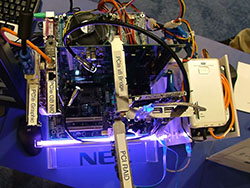 |
| Click to enlarge | |
These are a couple of shots from the NEC booth showing off their PCI Express bridge technology. "Doctor Frankenstein, meet PCI Express...." This monstrosity is obviously not meant to reside in any system but is meant as a demonstration that the chips work properly. Pretty much every storage technology other than Firewire was present and working (as far as we could tell). Also of note was that the main bridge card used an X8 connector plugged into an X16 slot, showing the downward compatible capability of PCI Express. Meanwhile, the system was connected to a monitor running - surprise - Windows Media Player with a DVD or HD video stream.
Phoenix UEFI
 |
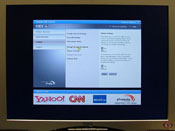 |
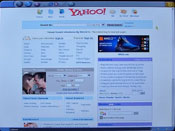 |
| Click to enlarge | ||
We mentioned EFI (Extensible Firmware Interface) briefly in the Day 1 coverage, and we actually saw a demonstration by Phoenix of their UEFI chip at the AMD booth. (UEFI = Universal Extensible Firmware Interface, which is the new version of EFI. Apparently Intel owns the EFI name or something.) You can see the "Hello, world!" equivalent of UEFI in the main menu, which allows booting via a standard BIOS or the new UEFI model. One of the interesting items we saw in the UEFI BIOS was a memory testing utility, along with a couple other diagnostics tools. As if that wasn't enough, it was also possible to connect to the Internet and browse the web. This was all apparently done through code running off the flash ROM in the motherboard, and we verified that the connection was real by pulling up the AnandTech web site. (We may have gained a new reader in the process.)
Sion Power Li-S
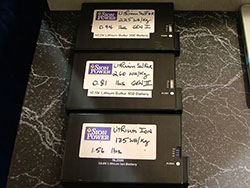 |
| Click to enlarge |
The road warriors of the world may find this next item interesting. Sion Power had some Lithium Sulfur (Li-S) batteries at their booth. The older first generation Li-S packed 225 WHr/Kg while the second generation batteries are able to increase that to 260 WHr/Kg. Lithium Ion sits down at 135 WHR/Kg, almost half the power to weight ratio of Li-S. There are two ways to go with Li-S, of course. The batteries at the booth were showing equivalent power in a lighter package, which will be useful for the thin and light segment. For higher end laptops (or even portable workstations), Li-S could provide double the battery life at the same weight, allowing moderate laptops to literally run all day. Sion Power said that they are basically at the beta stage right now, with full production hopefully coming in the next 12 to 18 months.
Just to satisfy our own curiosity, we asked them about fuel cells. Fuel cells could apparently pack 6000 WHr/Kg, but besides being dangerous (try taking a propane canister on an airplane), they're also only about 15% efficient. That means the 6000 WHr/Kg fuel cell can only deliver around 900 WHr/Kg of usable power, although that's still 3.5 times the potential of Li-S batteries. Sion Power felt that we were probably still 5+ years away from having usable fuel cell technology for computers, so Li-S or similar technologies are going to be useful for quite a few more years.
Eurocom Portable Workstations
We also saw some workstation class DTRs from Eurocom on the floor. These beasts include upgradeable custom PCI Express graphics cards (they explained to us that both MXM and Axiom have their flaws, so they had to roll their own). They are also planning on offering SLI configurations in their notebooks. We might just have to get our hands on one of these to compare to a desktop workstation. After all, what engineer wouldn't be happier designing anywhere other than their cube?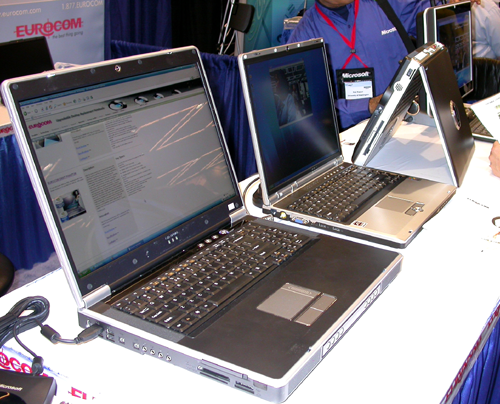










17 Comments
View All Comments
DerekWilson - Saturday, April 30, 2005 - link
heh ... not even the CPU editor has all the CPUs he needs. We've been passing our one set of dual core processors from both vendors around the globe. :-)JarredWalton - Friday, April 29, 2005 - link
The *official* plan is for Longhorn to be widely available by the holiday 2006 time frame (see day 1 coverage). However, I think XP-64 was supposed to be available over a year ago as well. Call me a skeptic....The point about going next year is that, from what I could tell, certain things are just repeated in slightly updated formats each year. Longhorn was discussed last WinHEC, and the information this time was simply a bit more concrete. There were still quite a few "this isn't yet finalized..." disclaimers throughout the presentations.
I suppose since I'm local to WinHEC (I'm in Olympia, WA), at the very least I'll be going to some of the MS events in the future. We'll have to see how that pans out. Maybe next time I can make it to the Sunday AMD Gaming gig and get a free Athlon 64 4000+? (Yeah, we missed out on that. Not that we don't have lots of hardware already, but having an extra CPU never hurts. Especially when you're not the CPU editor. Heheh)
PrinceGaz - Friday, April 29, 2005 - link
Fascinating. Probably the most relevent event report I've read. The IDF is interesting to see where the hardware is going, but it is the software that we use on a day to day basis, and what Microsoft are planning is likely to impact us the most in the next few years."At the end of the show, while we would definitely say that WinHEC doesn't have the appeal of Computex, E3, or some of the other larger shows, there was still plenty of good information to be found. Will we go again next year?"...
I can't believe you are even wondering whether to go again. Though if Anand is using his Mac all the time now and abandoned PCs, and those of you with PCs have switched from Windows to Linux, then I could understand your hesitation. I jest of course, but what happens with Microsoft is likely to be more important to the PC user than any hardware development, so there is no way you can neglect it.
I thought Longhorn was due out mid-2006, rather than "two years time". Longhron has seemed to be due out in "two years time" for quite a few years now, such that I wonder if it will ever actually arrive. And when it does arrive, will it actually contain many of the improvements originally touted over Windows 2000/XP (such as the central WinFS file-system which they decided would delay Longhorn too long). So are Microsoft officially saying 2007 is Longhorn year now?
Personally I'm in no hurry for Longhorn if it is crippled with DRM restrictions everywhere. The whole pointy of a PC is I can do what I wish with the media I have obtained, whether purchased or from other sources. I would say that being able to view perfect and complete "try before I buy" content has had the main effect with me of making me buy stuff I otherwise wouldn't have considered, rather than simply using it as an alternative to purchasing discs. Content protection that limits consumer choice (even if that choice includes free downloads) is and always has been detrimental to the industry.
JarredWalton - Friday, April 29, 2005 - link
DOS is still in use as a deployment tool. You can still license DOS from MS, but that will cease to be the case as of 2006. I work as an IT guy for a huge corporation, and our PC build process goes like this:1) Boot from floppy.
2) Select PC configuration.
3) Watch Drive Image clone the XP image to the HDD.
4) XP loads up and finishes the device enumeration, joins the appropriate domain, etc.
5) Choose SMS pacakages and wait.... (The final stages of the build process can take as long as an hour or two, depending on the SMS packages that are selected for installation.)
The problem is that getting DOS network drivers as well as support for newer technologies (SATA) is getting more and more difficult. The whole setup process would be more streamlined if HQ personnel didn't have to worry about DOS. I would wager that we'll still continue to use DOS and Drive Image for at least another 5 years, just because that's the way this corporation is, but it's nice to know that eventually they'll be forced to update the process to something that is hopefully faster and more robust.
icarus4586 - Friday, April 29, 2005 - link
"R.I.P. MS-DOS, 2005"This part of the article doesn't make much sense. The huge majority of Windows machines are either 2000 or XP, both of which are NT. NT does not run on DOS. MS-DOS was dead with WinME, and should have been dead far before.
ProviaFan - Friday, April 29, 2005 - link
Interesting stuff... Out of all of it, I found the (U)EFI coverage to be most intriguing, since normally the BIOS is one of the least represented PC components in computer news coverage. ;)stephenbrooks - Friday, April 29, 2005 - link
"One giant Microsoft fest"?? That got me saying "Ewww!" before I started the article. XD Images of hordes of Barney ActiMates™ coming to play with me came to mind.